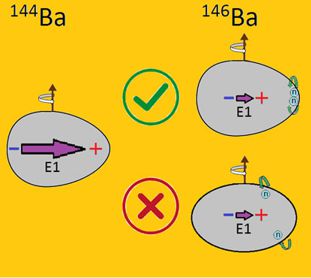The Difference a Pair of Neutrons Can Make
 Add barium-146 to the short list of pear-shaped nuclei, though this may be more surprising than one might expect given the pear-shaped nature of its nearby neighbor barium-144. Differing by only two neutrons, these two isotopes exhibit vastly different intrinsic (i.e. in the body-fixed reference frame) electric dipole moments (EDM). An intrinsic EDM can arise when the nuclear center of charge differs from its center of mass. Such is the case in Ba-144 where the pear-shape is expected to amplify the effect. However, when a pair of neutrons is added to form Ba-146, the charge-mass separation is quenched leading one to wonder if the nuclear reflection-asymmetry is quenched with it. Now an experiment has finally confirmed that this, indeed, is not the case and that the nuclear asymmetry is maintained despite the reduced dipole moment [1]. Additionally, new theoretical calculations explain that it is the nuclear pear-shape that alters the quantum levels of the individual neutrons leading to the quenched EDM when a pair of neutrons are added to Ba-144.
Add barium-146 to the short list of pear-shaped nuclei, though this may be more surprising than one might expect given the pear-shaped nature of its nearby neighbor barium-144. Differing by only two neutrons, these two isotopes exhibit vastly different intrinsic (i.e. in the body-fixed reference frame) electric dipole moments (EDM). An intrinsic EDM can arise when the nuclear center of charge differs from its center of mass. Such is the case in Ba-144 where the pear-shape is expected to amplify the effect. However, when a pair of neutrons is added to form Ba-146, the charge-mass separation is quenched leading one to wonder if the nuclear reflection-asymmetry is quenched with it. Now an experiment has finally confirmed that this, indeed, is not the case and that the nuclear asymmetry is maintained despite the reduced dipole moment [1]. Additionally, new theoretical calculations explain that it is the nuclear pear-shape that alters the quantum levels of the individual neutrons leading to the quenched EDM when a pair of neutrons are added to Ba-144.
References:
- Direct evidence for octupole deformation in 146Ba and the origin of large E1 moment variations in reflection-asymmetric nuclei, B. Bucher et al., Phys. Rev. Lett. 118, 152504 (2017)
![[Argonne Logo]](/images/argonne_header_logo.jpg)
![[DOE Logo]](/images/header_doe.gif)